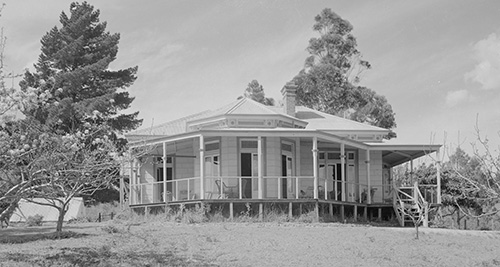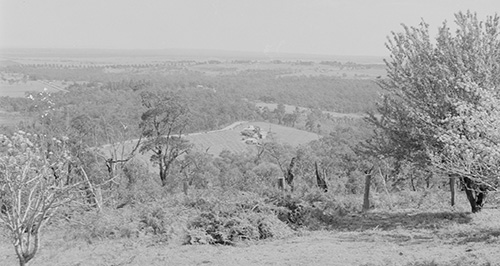Kyogle (previously Ben Eay)
(PAK-66 - Lot 10)


On 25 September 1885 Martha (Patty) McKenzie bought 12½ acres of land from Joseph Bulling, a builder who had recently built Fernacre.
On her land, in late 1885, under the supervision of W. S. Law, architect, Martha had a country residence built, containing 7 bedrooms. This residence she named Ben Eay, after a mountain in Ross-shire, the ancestral place of her father. Martha's father, John Murchison, who had died in 1882, provided well for his eldest daughter, leaving her a sum of £2000 upon trust, from which she would receive the interest, her sisters would receive a legacy of £450 each. There were a number of mortgages on Ben Eay's title, and it appears that the family solicitor advanced £1000 from her trust account, which was secured against her property. It is not known how long Patty lived in this house, Upper Beaconsfield being a town well known for weekend visitors, some having their own properties, others making use of the many guesthouses and hotels that catered for them.
By 1888 she let it be known that she was keen to sell her property, but the 1890s depression would have prevented her from selling. Instead, by 1895, but possibly earlier, she let the house to the Hedrick sisters, Annie Thomson Hedrick and Barbara Amy Hedrick, who advertised Ben Eay as a guesthouse taking visitors. In 1896 they had the opportunity to take over a much bigger guesthouse in the village, Kincraik, which they renamed Salisbury House. Ben Eay was then let to the Brown family, and used as a family home as well as a guest house. It appears that the Browns stayed at Ben Eay until Martha McKenzie's unmarried daughters sold the house to the Fowler sisters Florence Kate Fowler, Ellen Elizabeth Fowler and Miriam Fowler on 21 January 1914, five years after Martha's death.
The Fowlers had previously operated Kanoona, but saw a better prospect in Ben Eay, which they renamed Kyogle. The Fowler sisters operated Kyogle as a guesthouse for about five years, then sold it for £750 to Constance Ellen Jackson (nee Tunks), who sold it to John Percy Arthur 18 months later. Arthur let the house to Jack Ashley and his family, who lived there for about two years.
On 20 Apr 1923 the local newspaper reported that a bush fire had broken out in the gully in front of Lynwood, and soon swept the sides of the hills. Mr Jack Ashley's house was in great danger of being burnt, but owing to the splendid efforts of the residents who turned out in force to beat back the fire, the homestead was saved. The flames were within a few chains of the house, and an anxious time was spent by Mrs Ashley and family.
The house had been advertised for sale for £1250 in late March 1923, and was bought on 23 June 1923 by Ellen Gulinda Brumley and Wells Brumley. During their ownership Kyogle was used as a private residence, until in 1939 they sold it to Helena Barnes, who lived at Alston, the neighbouring property.
During Helena's ownership the Elizabeth McDonald advertised Kyogle as a guest house again. Elizabeth (Bessie) McDonald and David McDonald, describing themselves as guest house proprietors, bought Kyogle on 23 Feb 1949, but going by the electoral rolls, they may have been living at Kyogle from as early as 1934. They advertised it for sale on 22 Jul 1953:
UPPER BEACONSFIELD. "KYOGLE," MAIN ROAD. SPLENDID TIMBER VILLA. VACANT POSSESSION.
Contains Spacious Lounge-room, Large Dining-room, 7 Bedrooms, Sleepout, Kitchen, with Aga stove, HWS, Bathroom. LAND APPROX 12 ACRES, Views of Surrounding Countryside extending to Sea. £2000.
The next owners were William Dwyer and Hilda May Dwyer of St Kilda, who owned the property from 20 Jul 1954 until 8 Dec 1959, when Thomas Frederick Rickards and Elizabeth Daisy Rickards bought it.
In 1975 Tom Rickards sold Kyogle to Greg and Carol Ross, who still owned it when the Ash Wednesday Bushfires destroyed many houses in Upper Beaconsfield. Kyogle was one of them.
.jpg)